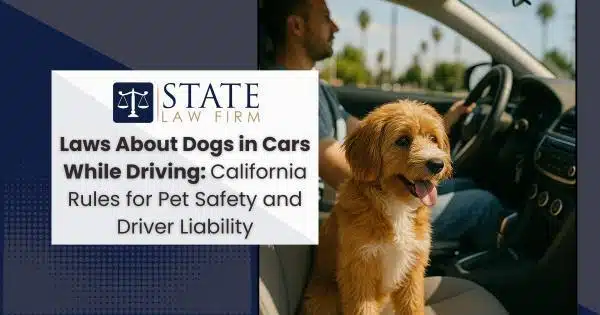Whether you’re taking your dog on a quick trip to the vet or embarking on a long California road adventure, it’s essential to understand that how you transport your pet can have legal consequences. In California, driving with an unrestrained dog in your vehicle isn’t just a matter of distraction—it could expose you to liability if an accident occurs or lead to penalties for violating state laws on pet safety.
According to a survey by the American Automobile Association (AAA), over 52% of pet owners admit to engaging in distracting behavior while driving with their dog, such as petting them or letting them sit on their lap—habits that significantly increase the risk of crashes. [Source: AAA Foundation]
At State Law Firm, our team of Sherman Oaks car accident attorneys has witnessed firsthand how easily a routine drive can turn into a life-altering event when drivers fail to take proper precautions. If you’re involved in a crash, knowing your rights—and the laws about transporting pets—can make all the difference. In some cases, traffic camera footage can even be used to demonstrate whether a pet played a role in causing or worsening an accident.
This article will guide you through California’s current laws on dogs in vehicles, discuss safety best practices, and outline the potential consequences of non-compliance. Whether you’re a seasoned driver or a new pet owner, staying informed is the first step toward keeping both you and your furry companion safe.
Understanding the Legal Framework for Pets in Vehicles in California
In California, pets—especially dogs—are considered part of the family. However, the law draws a clear line regarding their safety during car travel. The California Vehicle Code and various animal welfare statutes outline the requirements for transporting pets to ensure public safety and prevent animal abuse and neglect.
For example:
- California Vehicle Code Section 23117 prohibits transporting an animal in the back of a truck unless it is properly restrained.
- Animal cruelty laws may apply if a dog is left in a car under dangerous heat conditions or in a way that endangers their well-being.
- Local ordinances in cities like Los Angeles and San Diego may impose stricter rules, particularly regarding restraint and unattended animals in vehicles.
Pro Tip: Even if your dog seems calm in the car, a sudden movement or loud noise can turn them into a dangerous distraction. Understanding these legal parameters is essential—not just to avoid penalties but to keep everyone in the vehicle safe.
The Importance of Pet Safety While Driving: Protecting Your Dog and Yourself
Driving with a pet can be comforting, but it also presents serious safety risks if the animal is unrestrained or anxious. Dogs roaming freely in a vehicle can block your view, interfere with the pedals, or cause you to take your hands off the wheel.
A 2021 survey by Volvo and The Harris Poll found that:
- 69% of pet owners admit to engaging in risky driving behavior with their pets.
- Unrestrained pets increase the likelihood of a crash by 300% during driving distractions.
Unsafe driving doesn’t just risk injury—it can become a liability issue if your pet contributes to a collision.
To keep your dog (and others on the road) safe:
- Never allow your dog to sit on your lap while driving.
- Avoid letting them stick their head out the window at high speeds.
- Use restraint systems to prevent sudden movements.
If you’re ever involved in an accident involving a pet, State Law Firm’s car accident attorneys are ready to evaluate your case. We know how these small details can impact liability and compensation.
California Regulations on Restraint and Transportation of Dogs in Vehicles
California law promotes the use of pet restraints and safe travel methods for animals in moving vehicles, not just for the pet’s welfare, but for public safety. However, regulations can vary by county, and the law often leaves it up to the driver to act responsibly.
Under California Vehicle Code Section 23117, dogs riding in the back of a truck must be either:
- In a secured crate or cage, or
- Properly restrained by cross-tethers that prevent them from falling or jumping out.
But even inside the vehicle, improper transport can spell trouble. According to the ASPCA Pet Health Insurance guide, the back seat is the safest place for your dog or cat. For cats, especially, carriers are essential to avoid driver distraction and potential injury from sudden stops.
Where Should My Dog Ride in the Car?
| Vehicle Type | Recommended Placement | Safety Considerations |
| Sedan | Back seat (belted or in crate) | Keeps the dog away from the airbags and foot pedals |
| SUV with cargo space | Crate in back or belted in the back seat | Crates must be secured to avoid sliding |
| Truck (no back seat) | Front seat (if only option), airbag turned off | Never let pets ride unrestrained in the truck bed |
Why Not Let Them Stick Their Head Out the Window?
While it might seem fun or freeing, allowing your dog to hang their head out the window can cause serious harm:
- Debris in the eyes: bugs, pebbles, or road particles can cause injury
- Ear damage: High winds irritate the soft tissue in dog ears, leading to pain or infection
- Fall risk: A sudden turn or stop could send your dog flying out of the car
Pro Tip: Open the back windows just a few inches—enough to let fresh air in, but not wide enough for your dog to poke their head through. And always engage your child lock, since some dogs have learned how to operate window buttons!
Traveling with Cats? Here’s What to Know:
- Always use a secured carrier in the back seat.
- Covering the carrier with a towel can reduce stress and motion anxiety.
- Never allow a cat to roam loose—they may panic, hide under the pedals, or leap onto the dashboard.
Takeaway:
When it comes to transporting pets in California, the law offers the basic framework, but responsibility lies with the driver. Failing to secure your dog or cat isn’t just risky—it could be used against you in a personal injury claim if an accident occurs.
At State Law Firm, our attorneys understand how even small decisions, such as not buckling your pet, can have significant legal implications. If you’ve been injured in an accident involving an unrestrained animal or if your pet was harmed due to someone else’s negligence, we’re ready to help you understand your rights and pursue justice.
The Consequences of Non-Compliance: Penalties for Violating Dog Travel Laws
Failing to follow California’s pet travel laws can lead to more than just a warning.
Potential consequences include:
- Fines up to $200 for violations of Vehicle Code §23117
- Animal cruelty charges if a dog is left in unsafe conditions (such as in a hot vehicle)
- Civil liability if an unrestrained dog contributes to a crash or injuries
- Increased insurance premiums or denied claims if insurers find you were at fault due to pet distraction
If a collision occurs and an investigation reveals a dog was improperly restrained or caused the distraction, it could undermine your case, even if the other driver was also partially at fault.
Need to prove who was liable? Traffic camera footage can often clarify key moments leading up to a crash. Our team knows how to retrieve and use this evidence to build stronger cases.
Best Practices for Traveling with Your Dog Safely and Legally in California
Safe travel starts with preparation and ends with your dog arriving stress-free and healthy. Here are a few best practices to keep in mind:
Before You Hit the Road:
- Feed your dog early to prevent motion sickness.
- Exercise beforehand to burn off energy and reduce restlessness.
- Pack essentials: food, water, leash, waste bags, and medical records.
During Travel:
- Use a restraint system appropriate for your dog’s size.
- Stop every 2–3 hours for bathroom breaks and water.
- Avoid opening windows fully to prevent accidents.
Helpful Travel Accessories:
- Crash-tested harnesses
- Travel crates with ventilation
- Dog seat covers and barriers
- Portable water bowls and cooling mats
Pro Tip: If your dog becomes anxious during drives, consult with your veterinarian about calming supplements or strategies. A calm dog is not only safer—it’s legally less risky, too.
Stay Informed About Dog Travel Laws to Ensure Safety and Compliance on the Road
In California, being a responsible pet owner means being aware of the law and taking proactive steps to protect both your pet and other drivers. Whether it’s ensuring your dog is safely restrained or understanding the potential consequences of unsafe transport, awareness can go a long way.
At State Law Firm, we don’t just help clients after accidents—we help them understand their risks before they become legal problems. If your pet was involved in an accident or you need help proving liability in a case where distractions played a role, our dedicated attorneys are here to fight for the outcome you deserve.
When it comes to the safety of your loved ones—furry or otherwise—don’t leave it up to chance.


